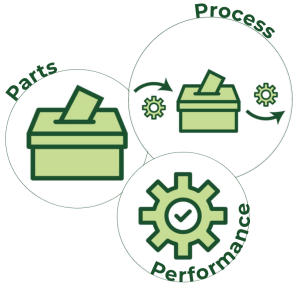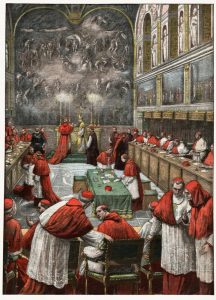Conclusion
Elections are everywhere. In 2025, 150,000 members of the liberal party of Canada voted to select a new leader who would automatically become Prime Minister. A month later, thousands of nurses in Alberta voted online to ratify their collective agreement. Soon after, a little over 10 million baseball fans cast votes to select the starting lineup for Major League Baseball’s All-Star Game. Voting is a default mode for making political decisions, both big and small. In the preceding nine chapters, we have examined the parts, process, and performance of electoral administration. Hopefully, this resource has provided some insight and information to help understand how elections work.
Parts, Process, and Performance
 We began this exploration by examining the districts, ballots, franchise and formula – the fundamental building blocks of an election. From the simple ballots of Canada’s Single Member Plurality (SMP) system to the elaborate ranked choice ballots used in Western Australia’s preferential voting system, we reviewed a variety of ballot configurations. These ballots serve as the user interface of an election, allowing the public to input their choice so the electoral system can translate those preferences into a representative government.
We began this exploration by examining the districts, ballots, franchise and formula – the fundamental building blocks of an election. From the simple ballots of Canada’s Single Member Plurality (SMP) system to the elaborate ranked choice ballots used in Western Australia’s preferential voting system, we reviewed a variety of ballot configurations. These ballots serve as the user interface of an election, allowing the public to input their choice so the electoral system can translate those preferences into a representative government.
Next, we looked at the vital functions performed by poll clerks, returning officers, and other election workers who prepare ballots, staff voting locations, and tabulate results. This is the thankless, underpaid, and almost invisible work that ensures the successful execution of an election. These functions are overseen by Electoral Management Bodies (EMB), which coordinate thousands of election workers to compile totals, conduct recounts, and communicate results to the public.
Election administrators must also work to protect the integrity of elections. In the final section, we reviewed the physical and digital threats that can compromise election security. Protecting against threats – both foreign and domestic – is vital for preserving public trust in elections, and that trust appears to be in decline around the world.
Simplicity and Complexity
Another noteworthy election took place in 2025 when the Catholic Church set out to select a replacement for the deceased pontiff, Pope Francis. Perhaps no election better exemplifies how electoral components work together than the papal conclaves held to elect a new pope.
Electing a New Pope

When a vacancy occurs, senior Cardinals from around the world (the voters) are summoned to the Vatican (the voting location) to begin the process.
Upon arriving, the Cardinals surrender phones and computers, they forgo newspapers and television, and they sever all contact with the outside world. These extreme security measures are intended to preserve secrecy (electoral integrity) and prevent any external actors from influencing the proceedings (foreign interference).
After enumerating the candidates, attendees write their choice on a piece of paper (write-in ballot). After all ballots are cast, each one is opened and read aloud (tabulation) to see if any candidate received a majority of the votes. If no candidate meets the threshold, additional rounds of voting are held (majority run-off) until one candidate receives over 50% of the votes.
To signal the selection of the new pope (communication of results), white smoke is released from the chimney at the Sistine Chapel.
Although the election of a pope by just 130 voters may appear trivial, it demonstrates the same underlying components found in elections everywhere. Granted, administration becomes more difficult as scale and complexity increase, but all elections combine the same basic elements: voters, districts, ballots, and an electoral formula. The parts are combined into a systematic process to solicit preferences, tabulate them, and communicate results, all within some defined electoral jurisdiction. Parts. Process. Performance.
What does the future hold?
Elections are never the same. From one election to the next, the voting population is different, with new voters reaching the minimum voting age and older voters aging out of the electorate (or dying). The economic conditions are variable, technology is advancing, and the norms that govern behaviour are always changing. The contexts in which elections are held can range from privation and scarcity to relative affluence and abundance. Future elections are bound to look different than their contemporary counterparts.
Elections in the Digital Age
 New technologies are becoming increasingly important in election administration. New tools and applications can help balance accessibility, usability, and security. For example, biometric identification markers such as fingerprints, iris scans, and facial recognition technology are all potential tools to guard against voter fraud in the voting and registration process; online and internet voting continues to grow in Europe as a means of reaching voters who may face barriers to voting; and the explosion of AI applications poses the ultimate threat to election integrity. The technologies will change, but the core functions remain: ensuring ballot access, protecting election integrity, and guarding against threats. Election administration will only grow in importance in the years to come.
New technologies are becoming increasingly important in election administration. New tools and applications can help balance accessibility, usability, and security. For example, biometric identification markers such as fingerprints, iris scans, and facial recognition technology are all potential tools to guard against voter fraud in the voting and registration process; online and internet voting continues to grow in Europe as a means of reaching voters who may face barriers to voting; and the explosion of AI applications poses the ultimate threat to election integrity. The technologies will change, but the core functions remain: ensuring ballot access, protecting election integrity, and guarding against threats. Election administration will only grow in importance in the years to come.

